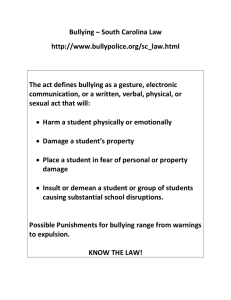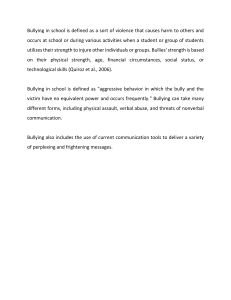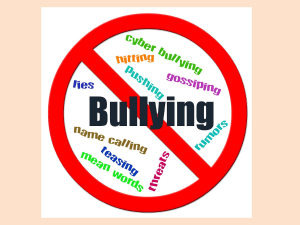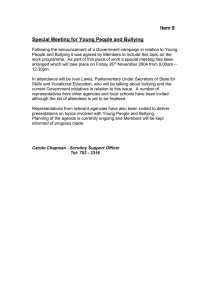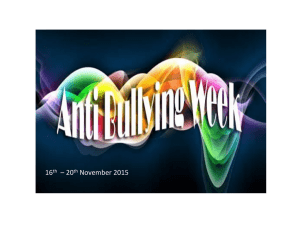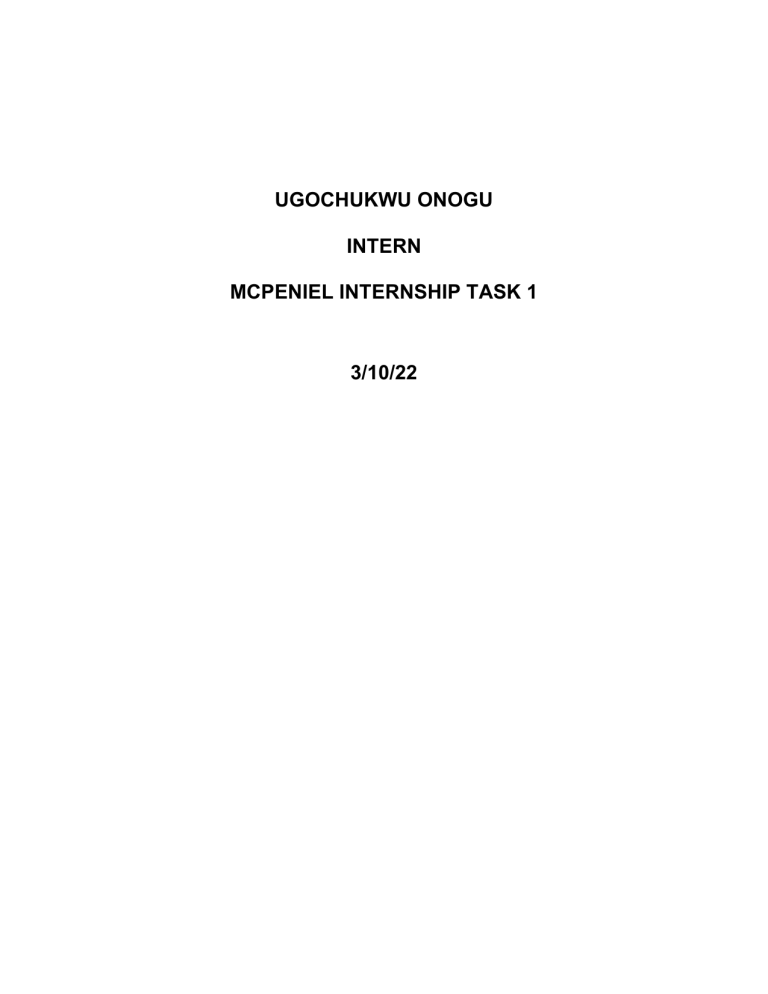
UGOCHUKWU ONOGU INTERN MCPENIEL INTERNSHIP TASK 1 3/10/22 1 Table of Contents INTRODUCTION ........................................................................................................................................ 3 BAD LEADERSHIP & ITS IMPACT ....................................................................................................... 4 Abusive leadership .............................................................................................................................. 4 Bullying ................................................................................................................................................... 5 Toxic leadership ................................................................................................................................... 6 THE EMERGENCE OF BAD LEADERS ............................................................................................... 8 Advice for leaders ................................................................................................................................ 8 Advice for followers ............................................................................................................................ 9 Conclusions............................................................................................................................................. 10 References ............................................................................................................................................... 11 1 2 TABLE OF FIGURES Figure 1: Model of destructive and constructive leadership behavior (Einarsen, Aasland, & 4 Skogstad, 2007) Figure 2: toxicity of the leadership dimension loadings 2 7 3 INTRODUCTION "Bad people make bad leaders." At first look, the aforementioned sentence will almost certainly elicit a nod from anybody who reads it. This may be true in some circumstances, but not as a general rule. Peter’s principle states that “The Peter Principle is an observation that the tendency in most organizational hierarchies, such as that of a corporation, is for every employee to rise in the hierarchy through promotion until they reach a level of respective incompetence.” Peter’s principle simply expressed, indicates that because someone excelled in a capacity doesn’t suggest the person would flourish in a leadership position that comes in form of a “promotion”. Hence not all who perform badly as leaders (Bad leadership) are “Bad leaders”. This document is aimed at critically investigating this concept and exploring the link between these two components (Bad Leaders & Bad Leadership) and eventually verifying if truly there's a karma impact or not. 3 4 BAD LEADERSHIP & ITS IMPACT From internet research the term ‘BAD LEADERSHIP’ has a lot of definitions. However, Einarsen, Aasland,& Skogstad (2007) created a model that best describes all sides of this subject matter as illustrated in Figure 1. Figure 1: Model of destructive and constructive leadership behavior (Einarsen, Aasland, & Skogstad, 2007) Figure 1’s correlations make it obvious which behaviors are regarded destructive leadership (anti-subordinate and/or anti-organization behavior) and which behaviors are considered constructive leadership (pro-subordinate and/or pro-organization behavior). Each destructive leadership approach combines the bad leadership traits that are covered in more detail below. Abusive leadership According to Tepper (2000) and Tepper, Duffy, Hoobler, & Ensley (2004), Leaders that are deemed abusive are differentiated by their deeply offensive activities, which include “public mockery, violent outbursts, thoughtless actions including rudeness, favoritism, non-contingent punishment, and coercion”. 4 5 Mawritz, Mayer, Hoobler, Wayne, and Marinova (2012) revealed that the impacts of abusive supervision extended beyond the supervisor-subordinate social context, which appears to be a common indicator of harmful leadership styles, according to multiple studies. Tepper (2007) found three factors that contribute to abusive supervision: perceived psychological contract violations, unfavorable emotions, and organizational injustice. According to Aryee, Chen, Sun, and Debrah (2007) argument, supervisors' views of interpersonal unfairness and authoritarian leadership style combine to affect abusive supervision as a counterproductive activity. More so than procedural justice, subordinates' judgments of interactional fairness explain how abusive supervision affects emotional organizational commitment. Bullying According to Pelletier (2010), bullying is the use of mental or physical strength against someone who is likely to be in a weaker or subordinate position to the one who is bullying. Schmidt (2008) observed that bullying differed sufficiently from supervisory abuse, such as abusive supervision, in breadth and purpose. Bullying at work is defined by Einarsen, Hoel, Zapf, and Cooper (2003) as bothering, insulting, socially excluding, or negatively impacting someone's job activities. Bullying, or mobbing, must occur regularly and habitually (e.g., weekly) and over a length of time (e.g., about six months) in order for the term to be associated to a specific activity, interaction, or process. Bullying that fosters teamwork in a supervised boot camp training activity, for example, is not necessarily harmful. Alexander, MacLaren, O'Gorman, and Taheri (2012) discovered that workplace bullying increased group cohesion, citing a long history of quasi-abusive practices used by military leaders in boot camp and Special Forces training as examples of toxic leadership behaviors that can actually build camaraderie and feelings of connectedness among followers. Bullying appears to be mostly a state inferred by a susceptible target of aggressive behavior. Hoel and Cooper (2001) defined this construct as "one or more individuals over 5 6 time who believe themselves to be on the receiving end of negative behaviors from one or more others, in a setting where the target of bullying has trouble defending himself or herself against these activities." Toxic leadership Lipman-Blumen (2005), a pioneer in toxic leadership research, classified it as "...a process in which leaders, through damaging action and/or dysfunctional personal attributes, inflict severe and enduring suffering on their followers, organizations, and nonfollowers alike. Toxic leaders demonstrate detrimental activities that weaken the morale, motivation, and self-esteem of their followers. According to Lipman-Blumen (2005), toxic leaders exhibit the following dysfunctional characteristics: a lack of ethics, insatiable ambition, arrogance, and big egos. Toxic leaders present a daily challenge to suffering subordinates, which typically leads in unwanted organizational stress, negative values, and despair. According to Lipman-Blumen (2005), the type and degree of unfavorable repercussions that an individual toxic leader creates may fluctuate depending on the circumstances. According to Steele (2011), toxic leaders are often not incompetent or poor in terms of fulfilling established mission objectives. He mentioned multiple times that they are powerful leaders with the necessary things, but in the wrong intensity and with the improper final end-state, namely self-promotion above everything else. Finally, in the authors' factor analysis, Schmidt's quantitative study (see Figure 2) incorporated factor loadings of toxic leadership characteristics to illustrate the amount to which a factor explains a variable. 6 7 Figure 2: toxicity of the leadership dimension loadings In summary, each destructive leadership style consists of a special combination of unfavorable leadership traits. 7 8 THE EMERGENCE OF BAD LEADERS A number of important and fundamental questions must be posed and addressed in order to comprehend this issue. These concerns include: These questions include: • Why isn’t the process of identifying who will be a good leader failsafe? • How should organizations handle a brilliant candidate who blatantly lacks critical leadership abilities but nonetheless appears to be able to produce outstanding results? • Why aren’t bad leaders recognized long before they bring woe to shareholders? The process of selecting leaders is the first stage. Typically, businesses select their top executives from a pool of applicants who have been vetted in managerial positions over several years. So how come the arrogant people get hired? Isn't there evidence of egotistic or self-serving behavior before they are chosen? Are front-line employees and direct reports being called into question? (James MacGregor, 1978) Once a candidate has been chosen, additional steps can be done to reduce the likelihood of poor leadership. The following suggestions are made for both leaders and followers: Advice for leaders • Determine what stakeholders value: To show the legitimacy of their approach, leaders must create and publish a clear description of their proposed strategy and long-term vision. Feedback from stakeholders will either support or contradict the plan, and competent leaders will respond positively to new information. (Robert J., 2007) • Listen to other views: Leaders' proclivity to make poor judgments can be reduced if they establish a network of peers and others who can provide them advice and criticism. Leaders must embrace dissent and promote other ideas even from within their own ranks of rebels. (Robert J., 2007) • Rely on the team: The team must support the leader's vision in order for it to be implemented. Furthermore, research indisputably demonstrates that communal decisions are better than individual ones (although "group thought" is always a 8 9 risk). Teams may help leaders create scenarios that investigate possible futures and explain the consequences of taking different actions. . (Robert J., 2007) • Foster a culture of integrity: Internalizing the organization's ideals will be made easier by developing a clear set of values and a code of conduct. Penalties are imposed for violations, while commendations are given for upholding the code. In the end, the company's principles are internalized, and its employees act morally out of instinct. . (Robert J., 2007) • Cultivate personal awareness: This is the most difficult task, since leaders, who are frequently isolated from stakeholders, can be lured by power; they find it simple to lie to themselves to satisfy their desires or world views. Leaders must have the ability to balance their own interests with the greater good, certainty and context, and intuition with facts. . (Robert J., 2007) Advice for followers • Give feedback: Although offering feedback might be hazardous, it must be forceful and daring since poor leaders seldom ever support opposing viewpoints. The final tactic for a follower may be to locate another job if the leader does not want to listen. . (Robert J., 2007) • Develop coalitions: "Strength comes in numbers" Followers may speak louder and move change forward faster by finding friends and working together. The dangers of bureaucracy and over centralization will be guarded against by a power balance. . (Robert J., 2007) • Regulate the organization: Governing authorities must intervene to safeguard stakeholder rights when self-regulation fails. examples are laws mandates independent audits, CEO and CFO certification of reports, and whistleblower protection. . (Robert J., 2007) 9 10 Conclusions It's evident that terrible leadership and bad leaders have a symbiotic relationship. Even while a bad leader does not always mean an incompetent leader, the growth of one is the first symptom of a culture of 'bad leadership' in that business. As a result, if bad leadership is sowed, bad leaders will undoubtedly be reaped. 10 11 References Einarsen, S., Aasland, M. S., & Skogstad, A. (2007). Destructive leadership behaviour: A definition and conceptual model. The Leadership Quarterly, 18, 207-216. Einarsen, S., Hoel, H., Zapf, D., & Cooper., C. (2003). Bullying and Emotional Abuse in the Workplace. International perspectives in research and practice. Taylor & Francis, London,, 165-184. James MacGregor, B. (1978). Leadership. Harper & Row. Lipman-Blumen, J. (2005). Toxic Leadership: A Conceptual Framework. Claremont, CA: Claremont GraduateUniversity. Matthew, A., Andrew, M., Kevin, D. O., & Babak, T. (2012). “He just didn’t seem to understand the banter”: Bullying or simply establishing social cohesion? Tourism Management 33(5), 1245–1255. Mawritz, M. B., Mayer, D. M., Hoobler, J. M., Wayne, S. J., & M. S. (2012). A Trickle-Down Model of Abusive Supervision. Personnel Psychology, 65 , 325-357. Pelletier, K. L. (2010). Leader toxicity: An empirical investigation of toxic behavior and rhetoric. Leadership, 6(4)., 373–389. Robert J., A. (2007). Bad leaders: how they get that way and what to do about them. Strategy and Leadership, 12-17. Schmidt, A. A. (2008). Development and Validation of the Toxic Leadership Scale. . College Park: University of Maryland. Steele, J. P. (2011). Antecedents and consequences of toxic leadership in the U.S. Army: A two year review and recommended solutions. . Center for Army Leadership,, 1-37. Tepper, B. J. (2007). Abusive Supervision in Work Organizations: Review, Synthesis, and Research Agenda. Journal of Management, June, 33(3), , 261-516. Tepper, B. J., Duffy, M. K., Hoobler, J., & Ensley, M. D. (2004). Moderators of the Relationships BetweenCoworkers’ Organizational Citizenship Behavior and Fellow Employees’ Attitudes. Journal of Applied Psychology, 89(3), 455-465. 11
